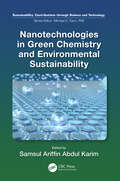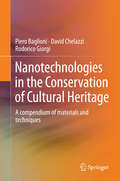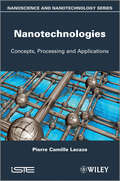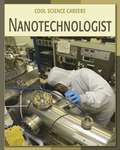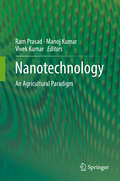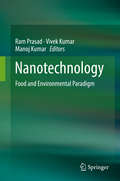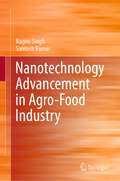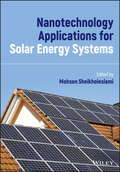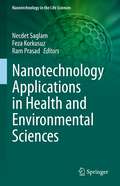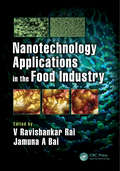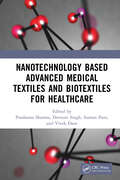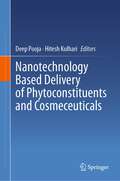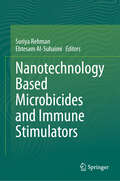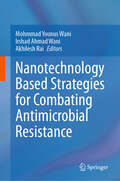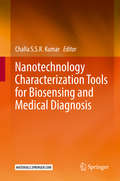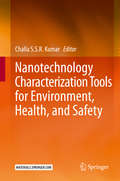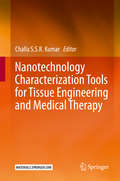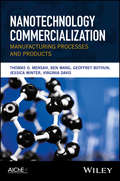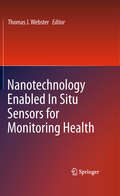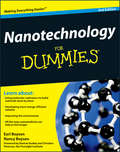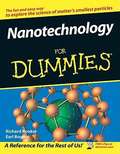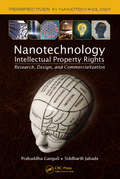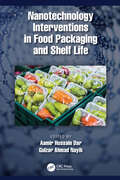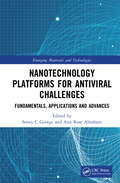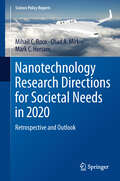- Table View
- List View
Nanotechnologies in Green Chemistry and Environmental Sustainability (Sustainability: Contributions through Science and Technology)
by Abdul Karim, Samsul AriffinNanotechnologies represent a fast-growing market and this unique volume highlights the current studies in applied sciences on sustainability of green science and technology. The chapters include modelling, machine learning, nanotechnology, nanofluids, nanosystems, smart materials and applications and solar and fuel cells technology. The authors cover simulation, additive manufacturing, machine learning and the autonomous system. Various aspects of green science as well as trans-disciplinary topics between fundamental science and engineering are presented.The book is suitable for all postgraduates and researchers working in this rapid growing research area. Features Presenting latest research on green materials and sustainability. Provide in depth discussion on modeling and simulation using latest techniques. Technical exposure for the readers on additive manufacturing principles. Numerous examples on nanofluids and nano technology are presented. Discusses computer modeling, superconductivity, nanotubes and related structures such as graphene.
Nanotechnologies in the Conservation of Cultural Heritage
by Piero Baglioni David Chelazzi Rodorico GiorgiThis book presents novel applications of nanotechnology for the preservation of artistic and historical artifacts. It explains the scientific principles behind numerous nanomaterials and discusses their applications to different types of common movable and fixed artistic substrates. It starts with an overview of the nano-tools developed over the last three decades, such as dispersions of nanoparticles, micellar solutions, microemulsions and gels. Compared to traditional methods, these new tools have the benefit of considerably less impact on both the operators and the environment. Each chapter is dedicated to a specific type of cultural heritage material (wall and easel paintings, stone, paper, canvas and wood) starting with the main degradation paths and discussing protocols for the application of innovative nanomaterials-based tools for cleaning, consolidation, or deacidification, which represent the majority of the case studies encountered in restoration facilities, workshops and ateliers. The book provides step-by-step descriptions that are meant to support conservators in the application of these novel materials and methods. The aim of the book is to equip end-users and conservators with essential information and knowledge on the availability and applicability of different nano-materials and dispersed systems. While the book's focus is on the practical aspects, interested readers will also find references to the relevant advanced colloid and material science literature. Main audience: Expert conservators, restorers and technical staff at conservation institutes and museums, students at conservation and restoration schools, and scientists who are new to the field of conservation of artistic and historical artifacts.
Nanotechnologies: Concepts, Production and Applications
by Pierre-Camille LacazeNanotechnologies: Concepts, Processing and Applications describes and explains how nanotechnologies have entered our everyday lives through scientific and industrial applications with the emphasis placed on the new perspectives in various fields related to societal problems. This book details how successive discoveries of new nanocarbon structures along with progress in different microscopy techniques have caused nanomaterials to take on an increasingly important role in electronics, electrochemical energy storage – batteries and fuel cells – and the electrical conversion of solar energy. Views once seen as futuristic on nanomachines and nanorobotics, therapeutic hopes and medical advances – such as those resulting from the application of new in-situ drug-delivery nanotechniques – are all presented. The most innovative developments are analyzed in terms of applications and should enable the reader to form his or her own opinion about the reality of the progress that can be expected from nanotechnologies in the near future. The book offers background reading for teachers in colleges who wish to have an overview on this subject.
Nanotechnologist (Cool Science Careers)
by Ann HeinrichsDid you ever wonder what it would be like to work with things so tiny you need special microscopes to see them? That is exactly what nanotechnologists do. These specialists work with the smallest units of matter to make new products and improve existing ones.
Nanotechnology
by Manoj Kumar Ram Prasad Vivek KumarThe New Frontiers of Organic and Composite Nanotechnology is an attempt to illustrate current status of modern nanotechnology. The book is divided into 3 main sections, introduction and conclusion. The introduction describes general questions of the problem and main lines of the research activities. In the first section methods of the nanostructures construction are described. Second section is dedicated to the Structure-property relationship. Special attention is paid to the description of the most powerful experimental methods and tools used in nanotechnology, such as probe microscopies, spectroscopied, and scattering methods, including the utilization of synchrotron radiation facilities. The third section describes the applications of nanotechnology in electronics, biotechnology and diagnostics. Conclusion part presents a summary of the status of works in this area and gives some perspectives of the further development. Reference to practically all original works with essential results, that resulted in the development of nanotechnology Coherent group of well-known authors in the field of nanotechnology Book spans topics applicable for both the didactic and research
Nanotechnology
by Manoj Kumar Ram Prasad Vivek KumarThe latest developments in nanotechnology and detailed application methodologies to decontaminate water, air, soil, and foodWritten by a team of global experts, "Nanotechnology for Environmental Decontamination" summarizes the techniques to structure target-specific nanomaterial, and how to apply it to decontaminate the natural environment from microbes, heavy metals, industrial toxic chemicals, chemical warfare agents, and biowarfare agents. Recent developments in nanotechnology enable environmental decontamination through several target-specific nanomaterials, processes, and tools. This groundbreaking work covers these innovative methodologies in complete detail. It is an ideal resource for both professionals and graduate-level students whose specialty is nanotechnology which is applicable to environmental decontamination. "Nanotechnology for Environmental Decontamination" featuresA thorough overview of the most important developments in the field of decontaminationNanomaterial design methodologies for specific targets such as microbes, heavy metals, and chemical/bio agentsContributions from world-renowned leaders in nanotech decontaminationCoverage of a wide variety of diverse applicationsIn-depth details on: Progress in the control of decontamination using nanotechnology; Nanomaterials as a means of decontamination; Photocatalytic inactivation: air and water; Decontamination of heavy metals from water; Nanotechnology as a tool: Removal of a dense nonaqueous phase liquid (DNAPLs) from the ground water; The remediation of microbes and toxic industrial chemicals from the wastewater; Reactive sorbent materials or systems for air-water remediation; The critical investigation of pesticides and explosive removal from soil and ground using innovative technology; Biocatalysts: the scavengers of chemical warfare agent, insecticides, pesticides, explosives, industrial toxic chemicals and heavy metals; Sequestration of greenhouse gases; Antimicrobial coatings and nanoemulsions used in decontamination; Commercial challenges of decontamination and nanotechnology
Nanotechnology Advancement in Agro-Food Industry
by Santosh Kumar Ragini SinghThis book provides a comprehensive insight into the growth of nanotechnology in the agri-food industry. Currently, nanotechnology serves as the most promising means to resolve the issues encountered in the food sector, as it enables the production of high-quality food with exceptional characteristics such as extended shelf life, flavor, freshness, and high nutritional content. This book focuses on the applications of nanotechnology in various fields such as smart packaging, processing, and preservation of food. It also emphasizes the role of nanomaterials in strategic design of nutraceuticals and functional foods. Along with providing an overview of the innovations and application, this book also describes future perspectives, and offers insights to ensure consumer confidence in terms of safe use. In this context the application of nanomaterials as nanosensors is additional covered. The book provides readers with a deep knowledge regarding nanomaterials-based biosensors (colorimetric, electrochemical, fiber-based) for detection of pathogens in contaminated food. Factors affecting risk assessment regulations and safety concerns regarding the use of nanomaterials in food industry have also been discussed in detail. Given its scope, this book appeals to a wider readership, especially for researchers and students who work in food agronomy and nanomaterials and nanotechnology related fields.
Nanotechnology Applications for Solar Energy Systems
by Mohsen SheikholeslamiNanotechnology Applications for Solar Energy Systems Understand the latest developments in solar nanotechnology with this comprehensive guide Solar energy has never seemed a more critical component of humanity’s future. As global researchers and industries work to develop sustainable technologies and energy sources worldwide, the need to increase efficiency and decrease costs becomes paramount. Nanotechnology has the potential to play a considerable role in meeting these challenges, leading to the development of solar energy systems that overcome the limitations of existing technologies. Nanotechnology Applications for Solar Energy Systems is a comprehensive guide to the latest technological advancements and applications of nanotechnology in the field of solar energy. It analyzes nanotechnology applications across a full range of solar energy systems, reviewing feasible technological advancements for enhanced performance of solar energy devices, and discussing emerging nanomaterials such as graphene and graphene derivatives. Nanotechnology Applications for Solar Energy Systems readers will also find: Detailed treatment of nanotechnology applications in systems including solar concentrating collectors, linear Fresnel reflectors, parabolic trough collectors, and more Coverage of methods to enhance the performance of solar energy devices including solar ponds and solar steam generators A comprehensive review of nanomaterials classification and the properties of nanomaterials in heat transfer and efficiency enhancement Nanotechnology Applications for Solar Energy Systems is critical for researchers in fields related to solar energy, engineers and industry professionals developing solar technology, and academics working in related fields such as chemistry, physics, materials science, and electrical engineering.
Nanotechnology Applications in Health and Environmental Sciences (Nanotechnology in the Life Sciences)
by Feza Korkusuz Ram Prasad Necdet SaglamNanoscience and nanotechnologies are leading to a major point to our understanding of nature. Nanotechnology can be generally defined as creation and use of nano-sized systems, devices, and structures which have special functions or properties because of their small size. This volume on Nanotechnology Applications in Health and Environmental Sciences focuses on biotechnological and environmental applications of nanomaterials. It covers popular and various nanomedical topics such as oncology, genetics, and reconstructive medicine. Additionally, many chapters give leading-edge information on nano-sensor applications and usage in specific disciplines. Also, two chapters on novel subjects have been included on Lantibiotics and microbiota. This book should be useful for nanotechnologists, microbiologists, and researchers interested in nanomedicine and nano-biotechnology, as well as environmental nanotechnology.
Nanotechnology Applications in the Food Industry
by V Ravishankar Rai Jamuna A BaiNanotechnology is increasingly used in the food industry in the production, processing, packaging, and preservation of foods. It is also used to enhance flavor and color, nutrient delivery, and bioavailability, and to improve food safety and in quality management. Nanotechnology Applications in the Food Industry is a comprehensive reference book containing exhaustive information on nanotechnology and the scope of its applications in the food industry. The book has five sections delving on all aspects of nanotechnology and its key role in food industry in the present scenario. Part I on Introduction to Nanotechnology in Food Sector covers the technological basis for its application in food industry and in agriculture. The use of nanosized foods and nanomaterials in food, the safety issues pertaining to its applications in foods and on market analysis and consumer perception of food nanotechnology has been discussed in the section. Part II on Nanotechnology in Food Packaging reviews the use of nanopolymers, nanocomposites and nanostructured coatings in food packaging. Part III on Nanosensors for Safe and Quality Foods provides an overview on nanotechnology in the development of biosensors for pathogen and food contaminant detections, and in sampling and food quality management. Part IV on Nanotechnology for Nutrient Delivery in Foods deals with the use of nanotechnology in foods for controlled and effective release of nutrients. Part V on Safety Assessment for Use of Nanomaterials in Food and Food Production deliberates on the benefits and risks associated with the extensive and long term applications of nanotechnology in food sector.
Nanotechnology Based Advanced Medical Textiles and Biotextiles for Healthcare
by Vivek Dave Prashansa Sharma Devsuni Singh Suman PantThis book provides systematic coverage of research into medical and biotextiles based on nanomaterials as applicable in healthcare. Divided into three sections, it explains manufacturing, properties, types, and recent developments in nanotechnology based medical textiles backed by case studies. It includes a wide range of different clinical applications of biotextiles for healthcare including nanotextile scaffolds, nano-based artificial organs, surgical sutures, enzymatic assisted enhanced biotextiles, tissue engineering or drug delivery system via nanofibers, and so forth.Features: Provides strong and broad overview of medical applications in the field of nano and biotextiles. Highlights different approaches, recent research, and emerging innovations. Covers designing or developing nanomaterials based antiviral surface disinfectants with self-cleaning property. Reviews different applications of nano based medical textiles such as deodorizing or pH control clothing for hygiene maintenance. Includes the real-life applications based descriptive case studies that offer a diverse range of perspectives. This book is aimed at researchers and graduate students in textile technology and engineering, and medical textiles.
Nanotechnology Based Delivery of Phytoconstituents and Cosmeceuticals
by Deep Pooja Hitesh KulhariThis book explores the role of nanotechnology in the delivery of natural phytoconstituents and cosmeceuticals. It presents polymeric nanocarriers, lipid-based nanocarriers, metal/metal oxide nanocarriers, protein nanocarriers, and dendrimers for the delivery of phytoconstituents. Further, it focuses on the usage of phytocompounds in various cosmeceutical products and nano delivery technologies used in the delivery of various cosmeceuticals. Finally, the book reviews the toxicity issues of nanoparticles in the delivery of phytoconstituents and cosmeceuticals and regulatory aspects for clinical applications of nano phytomedicines. This book is helpful for academicians and researchers working in pharmaceutical sciences, nano science, material science, plant science, and cosmetic science.
Nanotechnology Based Microbicides and Immune Stimulators
by Suriya Rehman Ebtesam Al-SuhaimiThis book reviews the use of nano-based drug delivery systems and biomaterials to enhance the immune system against infectious diseases. It focusses on the inbuilt immunoreactive properties of nanomaterials and the advancement in its engineering to modulate the immune system either via immune-stimulation or immunosuppression. The book further discusses the use of nanoparticle-based vaccines to improve vaccine efficacy, immunization strategies, and targeted delivery to achieve desired immune responses at the cellular level against infectious diseases. Perhaps, book focusses on nanoscale diagnostics that offer new approaches for sensitive health monitoring that are potable and can guide the use of nanoscale therapies. This book explores the potential of immunomodulatory nanotechnologies, focusing not only on their benefits, but also on biocompatibility, and toxicity concerns, while highlighting promising innovations in Interferon-based immune therapies and addressing key challenges in achieving safe, scalable nanotech products. The book would encompass broad topics to attract the diverse specialty of physicians, health professionals, students, faculty, and researchers of nanotechnology, nanomedicine, infectious diseases, public health, immunology, bacteriology, virology, pathology, biotechnology, toxicology, and biomedical technology.
Nanotechnology Based Strategies for Combating Antimicrobial Resistance
by Mohmmad Younus Wani Irshad Ahmad Wani Akhilesh RaiThis book provides a comprehensive overview of recent advances in nanotechnology as an alternative strategy for addressing antimicrobial resistance (AMR). Examining nanotechnology-based methods such as nanoencapsulation, drug delivery, and conjugation, the text highlights their successful application in treating microbial infections with reduced resistance and off-target toxicity. The introductory section outlines AMR and explores diverse mechanisms of microbial resistance, emphasizing the potential of nanotechnology to surmount these challenges. Subsequent chapters investigate the role of specific nanomaterials—metal nanoparticles, metal oxide nanoparticles, functionalized quantum dots, magnetic nanoparticles, bimetallic nanoparticles, nanocomposites, carbon nanomaterials, and polymer-based nanomaterials—in overcoming antimicrobial resistance. Several chapters focus on the efficacy of nanoemulsions as an antimicrobial delivery method, underscoring their inherent antimicrobial properties, capacity to enhance drug solubility, stability, bioavailability, and targeting potential at the organ and cellular levels. The concluding section provides a detailed review of liposomes, dendrimers-based nanoparticles, and micelles as drug delivery vehicles in the context of combating pathogens resistant to antimicrobials.
Nanotechnology Characterization Tools for Biosensing and Medical Diagnosis
by Challa S.S.R. KumarEighth volume of a 40 volume series on nanoscience and nanotechnology, edited by the renowned scientist Challa S.S.R. Kumar. This handbook gives a comprehensive overview about Nanotechnology Characterization Tools for Biosensing and Medical Diagnosis. Modern applications and state-of-the-art techniques are covered and make this volume an essential reading for research scientists in academia and industry.
Nanotechnology Characterization Tools for Environment, Health, and Safety
by Challa S. S. R. KumarTenth volume of a 40 volume series on nanoscience and nanotechnology, edited by the renowned scientist Challa S.S.R. Kumar. This handbook gives a comprehensive overview about Nanotechnology Characterization Tools for Environment, Health, and Safety. Modern applications and state-of-the-art techniques are covered and make this volume an essential reading for research scientists in academia and industry.
Nanotechnology Characterization Tools for Tissue Engineering and Medical Therapy
by Challa S. S. R. KumarNinth volume of a 40 volume series on nanoscience and nanotechnology, edited by the renowned scientist Challa S.S.R. Kumar. This handbook gives a comprehensive overview about Nanotechnology Characterization Tools for Tissue Engineering and Medical Therapy. Modern applications and state-of-the-art techniques are covered and make this volume an essential reading for research scientists in academia and industry.
Nanotechnology Commercialization: Manufacturing Processes and Products
by Jessica Winter Thomas O. Mensah Ben Wang Geoffrey Bothun Virginia DavisA fascinating and informative look at state-of-the-art nanotechnology research, worldwide, and its vast commercial potential Nanotechnology Commercialization: Manufacturing Processes and Products presents a detailed look at the state of the art in nanotechnology and explores key issues that must still be addressed in order to successfully commercialize that vital technology. Written by a team of distinguished experts in the field, it covers a range of applications notably: military, space, and commercial transport applications, as well as applications for missiles, aircraft, aerospace, and commercial transport systems. The drive to advance the frontiers of nanotechnology has become a major global initiative with profound economic, military, and environmental implications. Nanotechnology has tremendous commercial and economic implications with a projected $ 1.2 trillion-dollar global market. This book describes current research in the field and details its commercial potential—from work bench to market. Examines the state of the art in nanotechnology and explores key issues surrounding its commercialization Takes a real-world approach, with chapters written from a practical viewpoint, detailing the latest research and considering its potential commercial and defense applications Presents the current research and proposed applications of nanotechnology in such a way as to stimulate further research and development of new applications Written by an all-star team of experts, including pioneer patent-holders and award-winning researchers in nanotechnology The major challenge currently faced by researchers in nanotechnology is successfully transitioning laboratory research into viable commercial products for the 21st century. Written for professionals across an array of research and engineering disciplines, Nanotechnology Commercialization: Manufacturing Processes and Products does much to help them bridge the gap between lab and marketplace.
Nanotechnology Enabled In situ Sensors for Monitoring Health
by Thomas J. WebsterNanotechnologies are now being applied to health monitoring. Until recently, there has been little research into how to use nanotechnology and sensors in health monitoring. Nanotechnology Enabled In Situ Sensors for Monitoring Health summarizes the research efforts to design sensors based on nanotechnology that can be placed into the body to monitor health. Nanotechnology is being used at an unprecedented pace to both diagnose and treat diseases, rather than conventional approaches that diagnose and treat diseases in a different manner.
Nanotechnology For Dummies
by Nancy C. Muir Earl Boysen Christine Peterson Desiree DudleyThe bestselling introductory guide on nanotechnology?now revised and updatedThe world of nanotechnology is ever changing and evolving; this fun and friendly guide demystifies the topic for anyone interested in how molecule-sized machines and processes affect our everyday lives. The authors begin with explaining the background of nanotechnology and then examine industries that are affected by this technology. Aiming to educate and simultaneously dispel common myths, the book explores the many nanotechnology-enabled consumer products available on the market today, ranging from socks to face lotion to jet skis to floor cleaners, to name a few. Serves as a fun and friendly introduction to the fascinating topic of nanotechnologyDiscusses the various issues involving nanotechnology in the areas of environment, medicine, defense, and othersProvides real-world examples of everyday nanotechnology use such as floor cleaners, flash memory drives, face lotion, computer processors, and moreWritten in the accessible, humorous For Dummies style, Nanotechnology For Dummies, 2nd Edition provides an easy-to-understand overview of nanotechnology and its real-world implementation.
Nanotechnology For Dummies
by Earl Boysen Richard D. BookerThis title demystifies the topic for investors, business executives, and anyone interested in how molecule-sized machines and processes can transform our lives. Along with dispelling common myths, it covers nanotechnology's origins, how it will affect various industries, and the limitations it can overcome. This handy book also presents numerous applications such as scratch-proof glass, corrosion resistant paints, stain-free clothing, glare-reducing eyeglass coatings, drug delivery systems, medical diagnostic tools, burn and wound dressings, sugar-cube-sized computers, mini-portable power generators, even longer-lasting tennis balls, and more. Nanotechnology is the science of matter at the scale of one-billionth of a meter or 1/75,000th the size of a human hair Written in the accessible, humorous For Dummies style, this book demystifies nanotechnology for investors, business people, and anyone else interested in how molecule-sized machines and processes will soon transform our lives Investment in nanotechnology is exploding, with $3. 7 billion in nanotechnology R&D spending authorized by the U. S. government in 2003 and international investment reported at over $2 billion
Nanotechnology Intellectual Property Rights: Research, Design, and Commercialization (Perspectives in Nanotechnology #8)
by Prabuddha Ganguli Siddharth Jabade"We need to seamlessly integrate IPR in the standard graduate/post graduate courses in science, technology, commerce, creative arts, etc., without over burdening the students with law"—Dr Prabuddha Ganguli, CEO, VISION-IPRNanotechnology Intellectual Property Rights: Research, Design, and Commercialization offers an overview of the dynamics of development and commercialization in nanotech, where strategic integration of IP, R&D, and commercialization has become imperative. It demystifies issues of intellectual property rights (IPR) associated with research, design, technology transfer, and commercialization of innovations in technology-led areas such as nanotech. Gives all stakeholders vital information to instill confidence by helping them better understand their individual roles in the IPR process Designed for a diverse readership that may not have background knowledge of the legal nuances of IPR, this book clearly articulates techno-legal aspects of nano-related innovations to aid their effective integration into businesses. This resource stands apart by using numerous case studies and pictorial illustrations, addressing aspects ranging from ideation to commercialization of IP-enabled nanotechnology. It illustrates the evolving patent landscape in nanotechnology, explores the international patent classification system, and details patenting procedures in a range of jurisdictions, including search for nanotechnology prior art and creation of search strategies. The authors discuss patent-led nanotechnology businesses, presenting a wide range of case studies that address construction of valuable patent portfolios, growth of start-ups, and consolidation of IP-led nanobusinesses through mergers, acquisitions, joint ventures, strategic investments, etc. They also cover patent litigations in nanotechnologies and the significance of strategically crafting agreements related to IP transactions. In addition, they address compliance with contractual obligations, the importance of well-drafted patent specifications, and sensitive aspects of conducting techno-legal due diligence prior to the development and marketing of products. Also covered are vulnerabilities in challenging/defending the validity of patents and negotiating settlements. Integrating use of the IPRinternalise® model for capacity building in human and infrastructural resources, the authors assess the future of IP landscaping in nanotechnology. Here, they focus on patentability, public perception of risks to health and ecosystems, institutionalized management of intellectual property rights, and the steps that will be necessary to meet these and other such challenges on the way to realizing profits in nanotech.
Nanotechnology Interventions in Food Packaging and Shelf Life
by Aamir Hussain DarNanotechnology has revolutionized agriculture and food technology, improving the shelf life of foods through interventions of nanomaterials in the packaging. Smart materials, biosensors, nanobiosenors, packaging materials, nanocarbon dots, and nanodevices address aspects of the food industry, such as food safety, food security, and packaging and shelf life.Nanotechnology Interventions in Food Packaging and Shelf Life shows how nanotechnology has the potential to transform food packaging materials in the future.Nanotechnology applied to food packaging can increase the shelf life of foods, minimize spoilage, ensure food safety, and repair damaged packaging. Key Features Sheds light on benefits of nanotechnology in the food packaging industry Contains information on utilization of nanocellulose and nanofibrils in food packaging Provides an overview of nanosensor applications for shelf-life extension of different food materials This book presents a comprehensive review of new innovations in nanotechnology, packaging, preservation, and processing of food and food products. It serves as a useful tool for food engineers and technologists in the food packaging industry.
Nanotechnology Platforms for Antiviral Challenges: Fundamentals, Applications and Advances (Emerging Materials and Technologies)
by Soney C George and Ann Rose AbrahamNanotechnology provides an innovative platform for drug delivery and antiviral actions. This book discusses the utilization of nano-based formulations for the control of viral agents. The antiviral potential of green synthesized silver, chitosan nanoparticles encapsulating curcumin, photoinduced antiviral carbon nanohorns, and the role of carbon-based materials like fullerenes, and carbon nanotubes in the repression of viral antigens are explained. The book also covers nanomaterial-based solutions for SARS-CoV-2 and other viral infections. Features: Explains theory and practical applications of nanomaterials as antiviral agents. Reviews upscaling of nanomaterials from laboratory to fabrication stage. Illustrates nanocurcumin, silver nanoparticles, and carbon nanoparticles for biomedical applications. Highlights role of nanotechnology in effectively combating viral infections and pandemics. Includes case studies of specific pharma companies. This book is aimed at researchers, graduate students in materials science, microbiology and virology, and pharmaceutical sciences.
Nanotechnology Research Directions for Societal Needs in 2020
by Chad A. Mirkin Mihail C. Roco Mark C. HersamThis volume presents a comprehensive perspective on the global scientific, technological, and societal impact of nanotechnology since 2000, and explores the opportunities and research directions in the next decade to 2020. The vision for the future of nanotechnology presented here draws on scientific insights from U.S. experts in the field, examinations of lessons learned, and international perspectives shared by participants from 35 countries in a series of high-level workshops organized by Mike Roco of the National Science Foundation (NSF), along with a team of American co-hosts that includes Chad Mirkin, Mark Hersam, Evelyn Hu, and several other eminent U.S. scientists. The study performed in support of the U.S. National Nanotechnology Initiative (NNI) aims to redefine the R&D goals for nanoscale science and engineering integration and to establish nanotechnology as a general-purpose technology in the next decade. It intends to provide decision makers in academia, industry, and government with a nanotechnology community perspective of productive and responsible paths forward for nanotechnology R&D.
